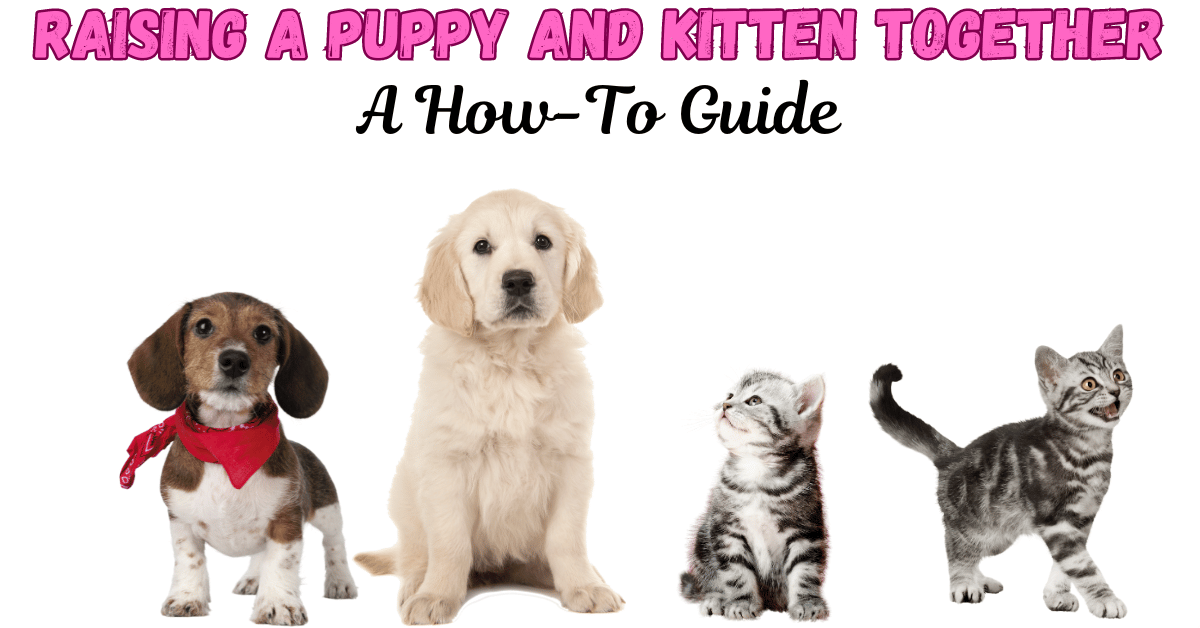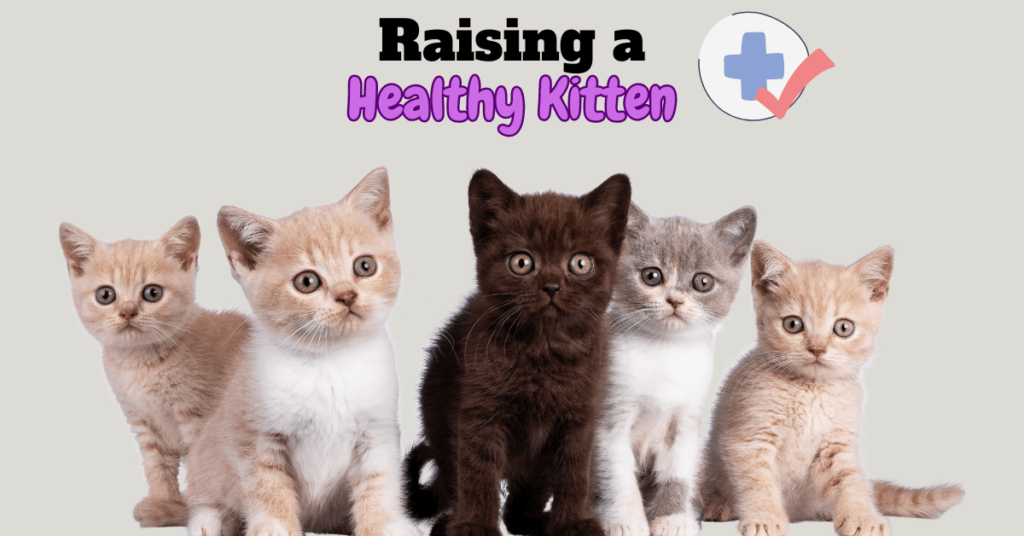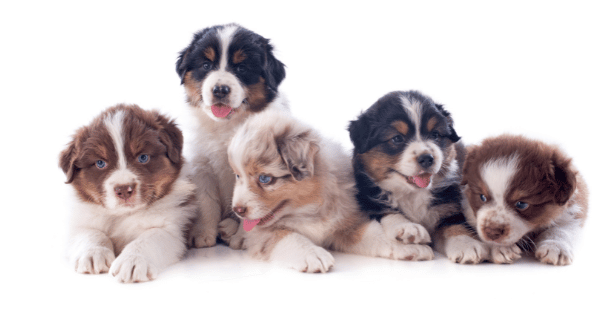This post contains affiliate links and I will be compensated if you make a purchase after clicking on my links.
The Delights of Deciding to Raise a Puppy and Kitten Together
Adopting a new kitten or puppy is a joyful experience, filling your home with their playful paws and curious whiskers. When you bring both a kitten and a puppy into your home, the fun and responsibilities double. This duo can grow up to be inseparable, providing endless entertainment with their antics.
However, raising them together requires thoughtful planning to ensure they become calm and confident companions. While they can form a strong bond from the start, potential challenges like a dog’s instinctual prey drive towards cats must be managed.
It’s crucial to start their relationship on the right foot—or paw. Taking strategic steps early on helps foster a positive, lifelong friendship between your new furry family members.
Overview of Key Steps to Raise a Puppy and Kitten Together
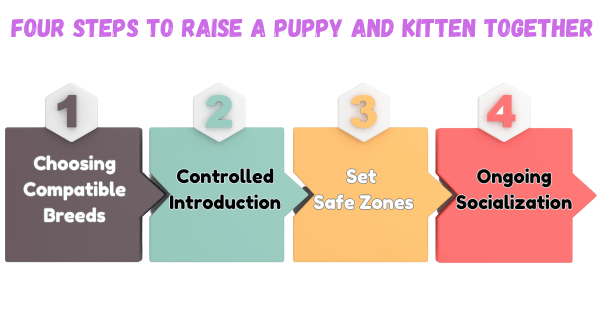
- Choosing Compatible Breeds: Select puppy and kitten breeds that are known for their compatibility and amiable nature to increase the likelihood of a harmonious relationship.
- Early Socialization and Controlled Introduction: Begin socialization during their sensitive periods and introduce your pets in a controlled environment to foster initial positive interactions.
- Setting Up Safe Zones and Separate Feeding Areas: Establish designated safe zones and separate feeding areas for each pet to minimize stress and prevent resource-based conflicts.
- Ongoing Interaction and Positive Reinforcement: Maintain regular, supervised play and interaction, using rewards for calm behavior to strengthen their bond as they grow.
Step 1: Choose the Right Breeds to Raise a Puppy and Kitten Together
The first and most crucial step in ensuring success when you raise a puppy & kitten together is selecting the right breeds. The compatibility of your pets’ temperaments and energy levels can significantly influence how well they get along as they grow.
Selecting the Right Puppy Breed
Dogs naturally possess a prey drive, a deep-rooted instinct to chase smaller animals inherited from their hunting ancestors. This is crucial to consider when introducing a puppy to a kitten.
Some dog breeds, such as the Greyhound, Australian Shepherd, Border Collie, and Doberman, exhibit stronger prey instincts, making them more inclined to view a kitten as a target.
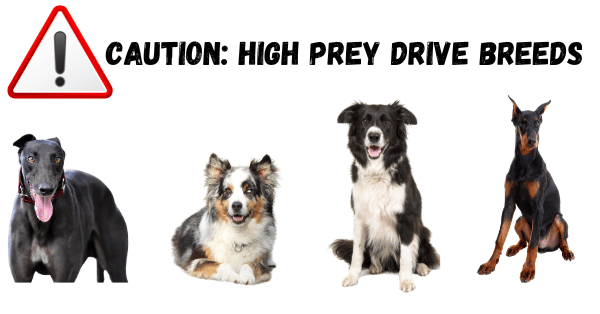
While it’s challenging, it’s not impossible to harmonize these breeds with a kitten, but it demands vigilant training and management of their instincts.
Conversely, breeds like Golden Retrievers, Pomeranian, Havanese and Cavalier King Charles Spaniels have a milder prey drive. These dogs tend to be more relaxed and tolerant, making them ideal companions for kittens due to their gentler nature and propensity to see kittens as friends rather than prey.
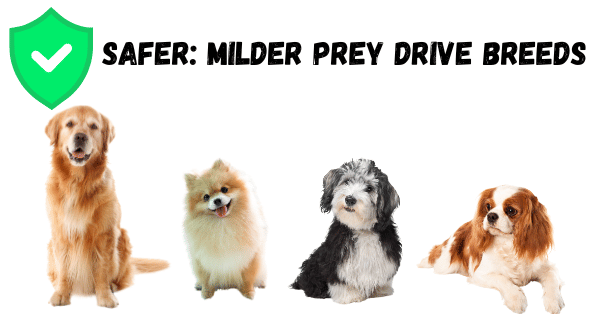
Choosing the Right Kitten
Like dogs, some cat breeds are naturally more sociable and well-suited for life with a puppy. Breeds like Ragdolls, Maine Coons, and American Shorthairs, known for their easygoing and affectionate natures, are less likely to be skittish and more open to befriending dogs, thereby easing the integration process.
Energy levels are crucial in determining how well a puppy and kitten will mesh. A high-energy Bengal cat paired with a laid-back Basset Hound might lead to mutual frustration.

Conversely, pairing pets with similar energy levels—whether high or low—ensures they can play harmoniously without overwhelming each other. Achieving this balance is essential for a peaceful coexistence where both pets can flourish.
Step 2: The First Introduction – Setting the Stage for Success
Early Socialization Period
Socialization ideally begins during the sensitive period—between 3 to 14 weeks for puppies and 3 to 9 weeks for kittens. This early phase is crucial for preparing them to enjoy interactions and be comfortable with various animals, people, places, and activities.
Controlled Introduction
With your puppy and kitten selected, the next crucial step is their first meeting. This should be done in a controlled environment to foster a successful relationship from the start.
A practical approach is using a baby gate or similar barrier, allowing the pets to see and smell each other without direct contact. This setup helps prevent any negative interactions that could disrupt their relationship early on.
During this initial encounter, it’s natural for some excitement, hissing, or barking as each pet establishes boundaries. The goal is to observe their reactions—positive or at least neutral—indicating they’re adjusting well to each other’s presence without signs of fear or aggression.
Tip: If your puppy and kitten are content doing their own thing while keeping an eye on each other, it’s a pawsitive indicator they’re on track to coexist comfortably and safely.
Step 3: Training Your Puppy for a Harmonious Household
Basic Commands
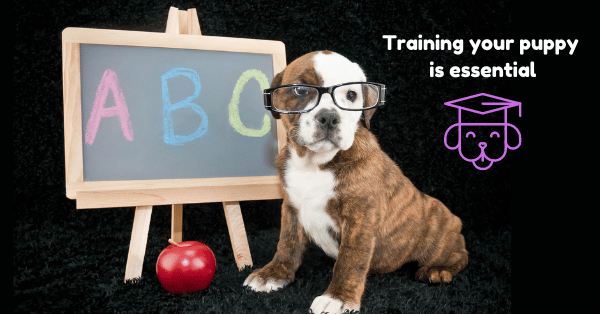
Begin training your puppy with essential commands like “Leave It,” “Stay,” “Stop,” and “Sit” to manage their zestful energy around your kitten. For instance, a timely “Leave It” can stop your puppy in their tracks, preventing a playful chase from turning stressful for your kitten.
Keep training sessions short and sweet, in tune with your puppy’s attention span, using treats and praises to reward calm interactions with the kitten. This not only promotes good behavior but also fosters a positive bond between the two.
Setting Up Safe Zones
It’s crucial to establish safe zones where both your puppy and kitten can retreat when they need a break. Equip your puppy with a crate to serve as a secure den, and provide your kitten with a high perch or a quiet, cozy spot. These safe havens are vital in the early stages of their relationship, allowing each pet to decompress and reducing potential conflicts.
Separate Feeding Areas
To avoid food-related squabbles, set up separate feeding areas for each pet. This keeps mealtimes peaceful and prevents territorial disputes over food. It also ensures that both your puppy and kitten receive the nutrition they need without interference from each other, keeping both healthy and happy.
Pro Tip: Never leave your puppy and kitten alone together unsupervised. When you’re away, ensure they’re kept in separate areas to prevent any unsupervised mischief or confrontations.
Step 4: Fostering Ongoing Socialization and Positive Relationships
Successfully raising a puppy and kitten together involves more than just initial introductions. It’s crucial to provide ongoing socialization and consistently positive experiences to foster a harmonious relationship as they grow.
Regular Interaction and Rewarding Calm Behavior
Engage your pets in regular, supervised playtime using interactive toys that appeal to both—like a feather wand for the kitten and a plush toy for the puppy. Monitor their interactions to ensure play remains gentle and enjoyable.
Mix active play with calmer activities, such as relaxing together while you offer treats or petting when they show peaceful behaviors. This not only strengthens their bond but also reinforces positive associations with each other’s company.
Continuously reward calm and friendly behaviors with treats, praise, and affection. If signs of fear or aggression arise, allow the pets to retreat to their safe zones, ensuring you move at a pace that suits both animals’ comfort levels.
Monitoring Growth and Adapting Strategies
As your puppy and kitten mature, their relationship and individual personalities will evolve. Regular veterinary check-ups are essential to monitor their health and behavior. If behavioral issues arise, consider consulting with an animal behaviorist to address specific concerns tailored to your pets’ needs.
Maintaining this relationship is a long-term commitment that requires patience, adaptability, and consistent reinforcement of positive interactions. Remain flexible and prepared to adjust your strategies as your pets grow and their dynamics change, ensuring they both feel secure and valued in their shared environment.
For example, as your kitten grows into a more confident cat, they may become more assertive in their interactions with the dog. Similarly, as your puppy matures, their behavior may calm down, but they might also become more territorial.
Raising a Puppy & Kitten Together: A Rewarding Journey
Successfully raising a puppy and kitten together is a fulfilling adventure that demands patience, consistency, and ample love. By selecting compatible breeds, introducing them positively in a controlled environment, and training your puppy to respect the kitten’s space, you set the stage for a lifelong friendship.
Remember, young pets like puppies and kittens should not interact with unvaccinated animals or explore areas where unvaccinated pets may have been until they’re fully vaccinated. With commitment and the right approaches, your pets can enrich each other’s lives—and yours—for years to come
Meet Sean, a fintech whiz with a penchant for pet purrs and blockchain buzz. After a decade of fintech feats, Sean’s tech talents leaped from ledger lines to litter lines, driven by a passion for pets and a vision for a more connected pet care community. With three critter companions as co-pilots, Sean launched this blog to share a treasury of pet-friendly tech tips and tales.

